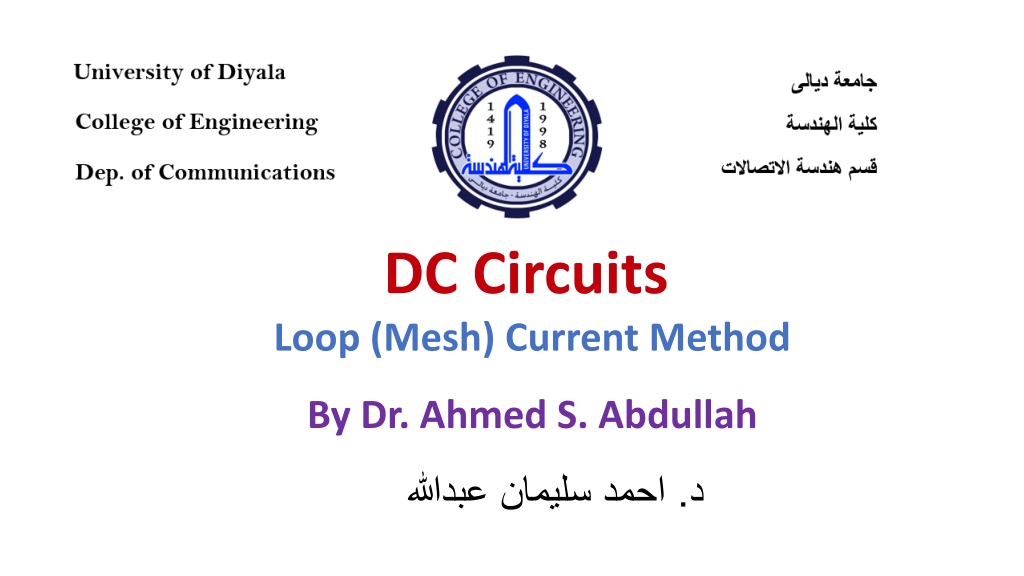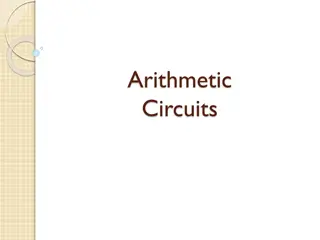Understanding DC Circuits: Mesh Current Method by Dr. Ahmed S. Abdullah
The DC Circuits Loop (Mesh) Current Method, explained by Dr. Ahmed S. Abdullah, applies Kirchhoff's Voltage Law (KVL) to find unknown currents in a circuit. This method involves assigning loop currents to loops, applying KVL to each loop, and indicating voltage polarities across all resistors based on the assigned loop currents. The process helps analyze complex circuits efficiently.
Download Presentation

Please find below an Image/Link to download the presentation.
The content on the website is provided AS IS for your information and personal use only. It may not be sold, licensed, or shared on other websites without obtaining consent from the author. Download presentation by click this link. If you encounter any issues during the download, it is possible that the publisher has removed the file from their server.
E N D
Presentation Transcript
DC Circuits Loop (Mesh) Current Method By Dr. Ahmed S. Abdullah .
Loop (Mesh) Current Method Loop (mesh) analysis applies KVL to find unknown currents. A mesh is a loop which does not contain any other loops within it.
Loop (Mesh) Current Method To illustrate the steps, consider the circuit in Figure shown.
Loop (Mesh) Current Method The first step requires that loop currents ??and ?? are assigned to loops 1 and 2. Although a loop current may be assigned to each loop in an arbitrary direction, it is conventional to assume that each loop current flows clockwise.
Loop (Mesh) Current Method As the second step, we apply KVL to each loop.
Loop (Mesh) Current Method As the second step, we apply KVL to each loop. Using the assigned loop currents, indicate the voltage polarities across all resistors in the circuit. For a resistor which is common to two loops, the polarities of the voltage drop due to each loop current should be indicated on the appropriate side of the component.
Loop (Mesh) Current Method As the second step, we apply KVL to each loop. Using the assigned loop currents, indicate the voltage polarities across all resistors in the circuit. For a resistor which is common to two loops, the polarities of the voltage drop due to each loop current should be indicated on the appropriate side of the component.
Loop (Mesh) Current Method As the second step, we apply KVL to each loop. Using the assigned loop currents, indicate the voltage polarities across all resistors in the circuit. For a resistor which is common to two loops, the polarities of the voltage drop due to each loop current should be indicated on the appropriate side of the component.
Loop (Mesh) Current Method As the second step, we apply KVL to each loop. Using the assigned loop currents, indicate the voltage polarities across all resistors in the circuit. For a resistor which is common to two loops, the polarities of the voltage drop due to each loop current should be indicated on the appropriate side of the component.
Loop (Mesh) Current Method As the second step, we apply KVL to each loop. Using the assigned loop currents, indicate the voltage polarities across all resistors in the circuit. For a resistor which is common to two loops, the polarities of the voltage drop due to each loop current should be indicated on the appropriate side of the component.
Loop (Mesh) Current Method As the second step, we apply KVL to each loop. Using the assigned loop currents, indicate the voltage polarities across all resistors in the circuit. For a resistor which is common to two loops, the polarities of the voltage drop due to each loop current should be indicated on the appropriate side of the component.
Loop (Mesh) Current Method As the second step, we apply KVL to each loop. Using the assigned loop currents, indicate the voltage polarities across all resistors in the circuit. For a resistor which is common to two loops, the polarities of the voltage drop due to each loop current should be indicated on the appropriate side of the component.
Loop (Mesh) Current Method As the second step, we apply KVL to each loop. Using the assigned loop currents, indicate the voltage polarities across all resistors in the circuit. For a resistor which is common to two loops, the polarities of the voltage drop due to each loop current should be indicated on the appropriate side of the component.
Loop (Mesh) Current Method The third step is to solve for the loop currents. Solve the resultant simultaneous linear equations by the determinants method.
Loop (Mesh) Current Method The third step is to solve for the loop currents. Solve the resultant simultaneous linear equations by the determinants method. =+6 4 +5= 6)(5 4 4 = 30 16 = +14 4 1 =+2 4 +5= 2)(5 4 6 = 10 24 = 14 6 2 =+6 +2 6= 6)( 6 2 4 = 36 + 8 = 28 4 ?1= 1 = 14 +14= 1 ? and ?2= 2 = 28 +14= 2 ? The minus signs indicate that the currents have a direction opposite to that indicated by the assumed loop current.
Loop (Mesh) Current Method EXAMPLEDetermine the current through the 8-V battery for the circuit of Figure shown.
Loop (Mesh) Current Method EXAMPLEDetermine the current through the 8-V battery for the circuit of Figure shown. Solution Convert the current source into an equivalent voltage source.
Loop (Mesh) Current Method EXAMPLEDetermine the current through the 8-V battery for the circuit of Figure shown. Solution Convert the current source into an equivalent voltage source. ? = ???= ? ? = ?? ?
Loop (Mesh) Current Method EXAMPLEDetermine the current through the 8-V battery for the circuit of Figure shown. Solution The equivalent circuit may now be analyzed by using the loop currents.
Loop (Mesh) Current Method EXAMPLEDetermine the current through the 8-V battery for the circuit of Figure shown. Solution
Loop (Mesh) Current Method EXAMPLEDetermine the current through the 8-V battery for the circuit of Figure shown. Solution Rewriting the linear equations, you get the following:
Loop (Mesh) Current Method EXAMPLEDetermine the current through the 8-V battery for the circuit of Figure shown. Solution Rewriting the linear equations, you get the following: Solving the equations using determinants, we have the following: =+5 3 +4= 5)(4 3 3 = 20 9 = +11 3 1 = 18 3 +4= 18)(4 3 +4 = 72 + 6 = 66 +2 2 =+5 18 +2 = 5)(2 18 3 = 10 54 = 44 3
Loop (Mesh) Current Method EXAMPLEDetermine the current through the 8-V battery for the circuit of Figure shown. Solution ?1= 1 = 66 +11= 6 ? and ?2= 2 = 44 +11= 4 ? If the assumed direction of current in the 8-V battery is taken to be I2, then ?? ?? ??? ???= ?2 ?1 = 4 6 = ? ? The direction of the resultant current is the same as I2 (upward).
Loop (Mesh) Current Method EXAMPLEFind the current through the 10 resistor for the circuit of Figure shown.
Loop (Mesh) Current Method EXAMPLEFind the current through the 10 resistor for the circuit of Figure shown.
Loop (Mesh) Current Method EXAMPLEFind the current through the 10 resistor for the circuit of Figure shown. Solution The loop equations are:- Loop 1: 8 + 3 ?1 3?2 8?3= 15 (3 + 5 + 2)?2 3?1 5?3= 0 Loop 2: Loop 3: (5 + 8 + 10)?3 8?1 5?2= 0
Loop (Mesh) Current Method EXAMPLEFind the current through the 10 resistor for the circuit of Figure shown. Solution The loop equations are:- Loop 1: 8 + 3 ?1 3?2 8?3= 15 (3 + 5 + 2)?2 3?1 5?3= 0 Loop 2: Loop 3: (5 + 8 + 10)?3 8?1 5?2= 0 Rearrange, then: Loop 1: 11?1 3?2 8?3= 15 3?1+ 10?2 5?3= 0 Loop 2: Loop 3: 8?1 5?2+ 23?3= 0
Loop (Mesh) Current Method EXAMPLEFind the current through the 10 resistor for the circuit of Figure shown. Solution Loop 1: 11?1 3?2 8?3= 15 3?1+ 10?2 5?3= 0 Loop 2: Loop 3: 8?1 5?2+ 23?3= 0 +11 3 8 3 +10 5 8 5 +23 = = 1168 +11 3 8 3 +10 5 +15 0 0 3= = 1425 ?3= 3 =1425 1168= ?.?? ? ?3= ?10 = ?.?? ?
Mesh Analysis with Current Sources Special cases CASE 1 When a current source exists only in one mesh: Consider the circuit in Figure shown,
Mesh Analysis with Current Sources Special cases CASE 1 When a current source exists only in one mesh: Consider the circuit in Figure shown, for example. We set ??= ? ? and write a loop equation for the other loop in the usual way; that is, Loop 2: ??= ? ? + ? ?? ???= ?? Loop 1: Rearrange, then: Loop 2: ??= ? ???? ???= ?? Loop 1: ???? ?( ?) = ?? ??=?? ?? ?? = ? ?
References Boylestad, Robert L. Introductory circuit analysis. Pearson Education, 2010. Robbins, Allan H., and Wilhelm C. Miller. Circuit analysis: Theory and practice. Cengage Learning, 2012. Sadiku, Matthew NO, and Chales K. Alexander. Fundamentals of electric circuits. McGraw-Hill Higher Education, 2007.























